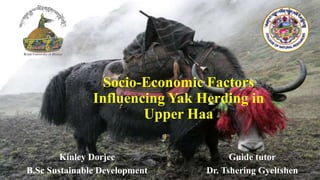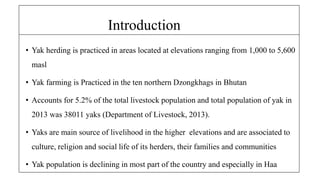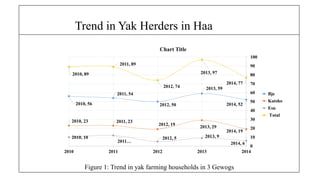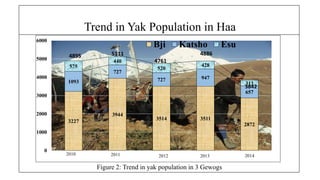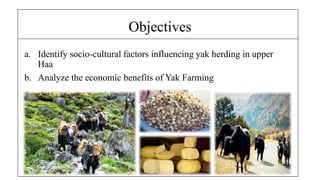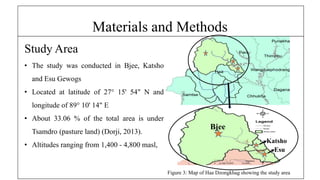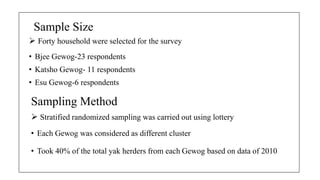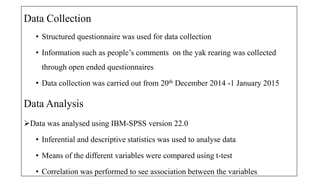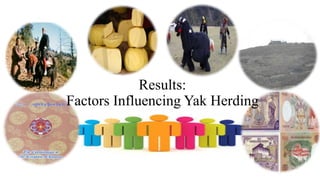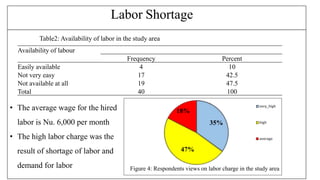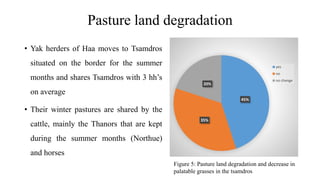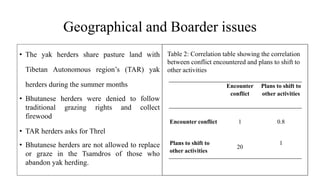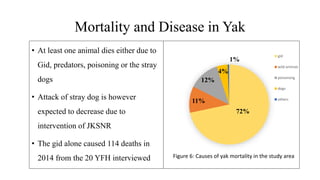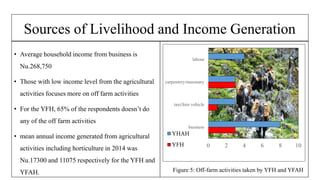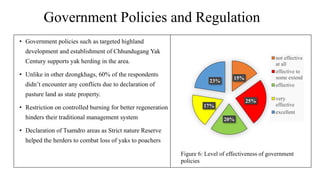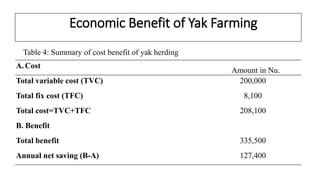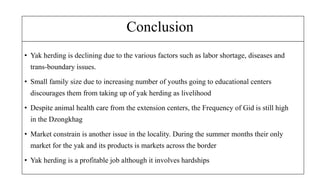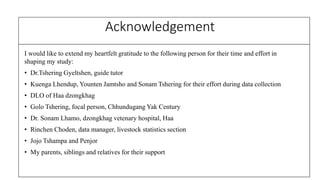factors influencing yak herding in upper haa
- 1. Socio-Economic Factors Influencing Yak Herding in Upper Haa Kinley Dorjee B.Sc Sustainable Development Guide tutor Dr. Tshering Gyeltshen
- 2. ? Yak herding is practiced in areas located at elevations ranging from 1,000 to 5,600 masl ? Yak farming is Practiced in the ten northern Dzongkhags in Bhutan ? Accounts for 5.2% of the total livestock population and total population of yak in 2013 was 38011 yaks (Department of Livestock, 2013). ? Yaks are main source of livelihood in the higher elevations and are associated to culture, religion and social life of its herders, their families and communities ? Yak population is declining in most part of the country and especially in Haa Introduction
- 3. Trend in Yak Herders in Haa 2010, 56 2011, 54 2012, 50 2013, 59 2014, 52 2010, 23 2011, 23 2012, 19 2013, 29 2014, 19 2010, 10 2011ĪŁ 2012, 5 2013, 9 2014, 6 2010, 89 2011, 89 2012, 74 2013, 97 2014, 77 0 10 20 30 40 50 60 70 80 90 100 2010 2011 2012 2013 2014 Chart Title Bje Katsho Esu Total Figure 1: Trend in yak farming households in 3 Gewogs
- 4. Trend in Yak Population in Haa 3227 3944 3514 3511 2872 1093 727 727 947 657 575 440 520 428 313 0 1000 2000 3000 4000 5000 6000 Bji Katsho Esu 4761 4886 3842 2011 20132012 20142010 Figure 2: Trend in yak population in 3 Gewogs 4895 5111
- 5. Objectives a. Identify socio-cultural factors influencing yak herding in upper Haa b. Analyze the economic benefits of Yak Farming
- 6. Materials and Methods Figure 3: Map of Haa Dzongkhag showing the study area Study Area ? The study was conducted in Bjee, Katsho and Esu Gewogs ? Located at latitude of 27ĪŃ 15' 54" N and longitude of 89ĪŃ 10' 14" E ? About 33.06 % of the total area is under Tsamdro (pasture land) (Dorji, 2013). ? Altitudes ranging from 1,400 - 4,800 masl, Bjee Katsho Esu
- 7. ? Forty household were selected for the survey ? Bjee Gewog-23 respondents ? Katsho Gewog- 11 respondents ? Esu Gewog-6 respondents Sample Size Sampling Method ? Stratified randomized sampling was carried out using lottery ? Each Gewog was considered as different cluster ? Took 40% of the total yak herders from each Gewog based on data of 2010
- 8. Data Collection ? Structured questionnaire was used for data collection ? Information such as peopleĪ»s comments on the yak rearing was collected through open ended questionnaires ? Data collection was carried out from 20th December 2014 -1 January 2015 Data Analysis ?Data was analysed using IBM-SPSS version 22.0 ? Inferential and descriptive statistics was used to analyse data ? Means of the different variables were compared using t-test ? Correlation was performed to see association between the variables
- 9. Results: Factors Influencing Yak Herding
- 10. Labor Shortage Availability of labour Frequency Percent Easily available 4 10 Not very easy 17 42.5 Not available at all 19 47.5 Total 40 100 35% 47% 18% very_high high average ? The average wage for the hired labor is Nu. 6,000 per month ? The high labor charge was the result of shortage of labor and demand for labor Figure 4: Respondents views on labor charge in the study area Table2: Availability of labor in the study area
- 11. Pasture land degradation ? Yak herders of Haa moves to Tsamdros situated on the border for the summer months and shares Tsamdros with 3 hhĪ»s on average ? Their winter pastures are shared by the cattle, mainly the Thanors that are kept during the summer months (Northue) and horses 45% 35% 20% yes no no change Figure 5: Pasture land degradation and decrease in palatable grasses in the tsamdros
- 12. Geographical and Boarder issues Encounter conflict Plans to shift to other activities Encounter conflict 1 0.8 Plans to shift to other activities 20 1 ? The yak herders share pasture land with Tibetan Autonomous regionĪ»s (TAR) yak herders during the summer months ? Bhutanese herders were denied to follow traditional grazing rights and collect firewood ? TAR herders asks for Threl ? Bhutanese herders are not allowed to replace or graze in the Tsamdros of those who abandon yak herding. Table 2: Correlation table showing the correlation between conflict encountered and plans to shift to other activities
- 13. Mortality and Disease in Yak 72% 11% 12% 4% 1% gid wild animals poisonong dogs others ? At least one animal dies either due to Gid, predators, poisoning or the stray dogs ? Attack of stray dog is however expected to decrease due to intervention of JKSNR ? The gid alone caused 114 deaths in 2014 from the 20 YFH interviewed Figure 6: Causes of yak mortality in the study area
- 14. Sources of Livelihood and Income Generation 0 2 4 6 8 10 business taxi/hire vehicle carpentery/masonary labour YHAH YFH ? Average household income from business is Nu.268,750 ? Those with low income level from the agricultural activities focuses more on off farm activities ? For the YFH, 65% of the respondents doesnĪ»t do any of the off farm activities ? mean annual income generated from agricultural activities including horticulture in 2014 was Nu.17300 and 11075 respectively for the YFH and YFAH. Figure 5: Off-farm activities taken by YFH and YFAH
- 15. Government Policies and Regulation 15% 25% 20% 17% 23% not effective at all effective to some extend effective very effective excellent ? Government policies such as targeted highland development and establishment of Chhundugang Yak Century supports yak herding in the area. ? Unlike in other dzongkhags, 60% of the respondents didnĪ»t encounter any conflicts due to declaration of pasture land as state property. ? Restriction on controlled burning for better regeneration hinders their traditional management system ? Declaration of Tsamdro areas as Strict nature Reserve helped the herders to combat loss of yaks to poachers Figure 6: Level of effectiveness of government policies
- 16. Economic Benefit of Yak Farming A. Cost Total variable cost (TVC) 200,000 Total fix cost (TFC) 8,100 Total cost=TVC+TFC 208,100 B. Benefit Total benefit 335,500 Annual net saving (B-A) 127,400 Table 4: Summary of cost benefit of yak herding Amount in Nu.
- 17. Conclusion ? Yak herding is declining due to the various factors such as labor shortage, diseases and trans-boundary issues. ? Small family size due to increasing number of youths going to educational centers discourages them from taking up of yak herding as livelihood ? Despite animal health care from the extension centers, the Frequency of Gid is still high in the Dzongkhag ? Market constrain is another issue in the locality. During the summer months their only market for the yak and its products is markets across the border ? Yak herding is a profitable job although it involves hardships
- 18. Acknowledgement I would like to extend my heartfelt gratitude to the following person for their time and effort in shaping my study: ? Dr.Tshering Gyeltshen, guide tutor ? Kuenga Lhendup, Younten Jamtsho and Sonam Tshering for their effort during data collection ? DLO of Haa dzongkhag ? Golo Tshering, focal person, Chhundugang Yak Century ? Dr. Sonam Lhamo, dzongkhag vetenary hospital, Haa ? Rinchen Choden, data manager, livestock statistics section ? Jojo Tshampa and Penjor ? My parents, siblings and relatives for their support
- 19. THANK YOU

